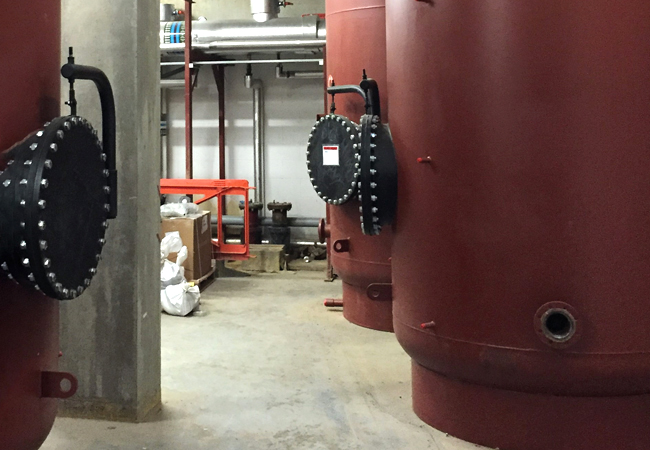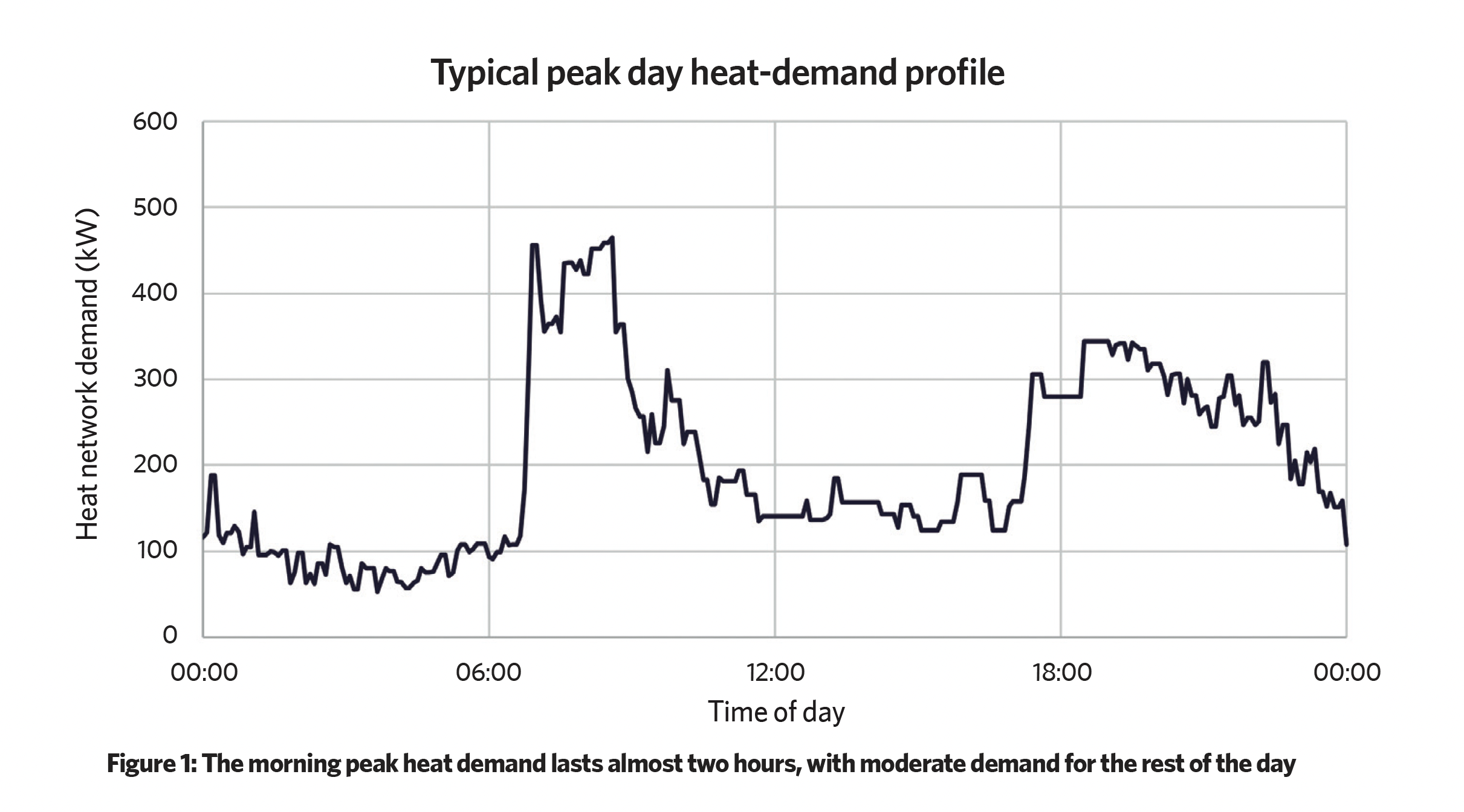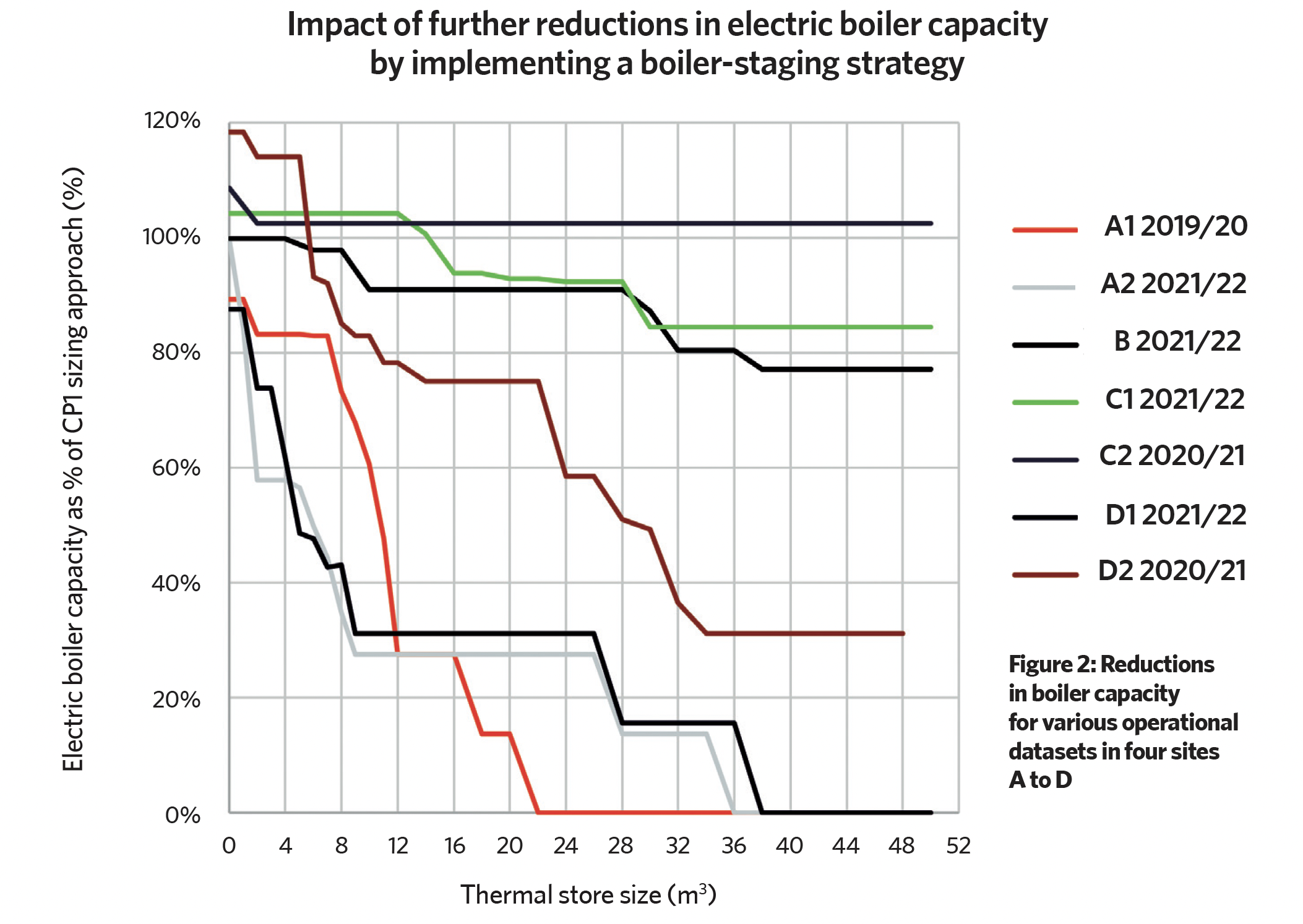
A thermal storage system in a district heating energy centre
The UK has set ambitious – but necessary – carbon-reduction targets, and heat networks are one solution for achieving these goals. These networks are transitioning from gas-fired to electrically powered heat sources, which means using heat pumps and electric boilers as primary sources of heat in a hybrid generation arrangement.
But how do we make sure these networks deliver low carbon heat efficiently? My latest research, presented at the FairHeat Annual conference and selected to feature in the CIBSE Technical Symposium 2023, provides valuable insight into this very question.
A frequent topic in design meetings with clients was the large anticipated electrical capacities required on site, and the developer expenditure on upgrades to the local grid to accommodate this.
I saw this as an area to explore and see if we could start to cut these costs through reductions to the total electric capacity, while maintaining network performances.
The FairHeat Graduate Scheme gave me the resources and support I needed to conduct this research, which not only enhances FairHeat’s knowledge base and practices, but is also shared with the wider industry for everyone’s benefit.
In the past, we have ventured into predictive hourly models to select heat pump and thermal storage sizes. However, the purpose of the research was to use operational heat network data to assess how the size of thermal storage would have impacted the required boiler capacity during the peak months: typically November to March.
The findings showed that by increasing and oversizing the thermal storage volume, it is possible that marginal reductions in electric boiler capacity, in the region of 15-30%, could start to be considered. This could result in capital cost savings for developers – but it also poses a risk that must be mitigated.
To explain, heat pumps have relatively high capital costs, so it’s optimal to maximise the thermal storage volume to minimise the required heat pump size for the majority of heat networks. This allows the heat pump to deliver a target annual heat fraction, with electric boilers used to meet peak demand.

Previously, it was acceptable to run the heat pumps to target 80% of the annual heat fraction when topped up by gas boilers. With the large running costs of electric boilers, however, supplying 20% of the heat fraction with these boilers is not achievable while maintaining a fair cost of heat. These days, we typically have to target a 95% heat fraction from the heat pump when topped up by electric boilers to maintain a fair cost to the end user.
The data from existing heat networks on residential schemes has provided a greater understanding of the heat-demand profile of the heating and hot water demands these networks serve. This data has previously been used to inform and optimise the sizing approach for the heat network distribution pipework and peaking plant, which, historically, was oversized significantly.
For example, in Figure 1, the morning peak demand is seen to last almost two hours, and remains with a moderate demand for the rest of the day. Historic designs have sized the thermal storage and allowed for far shorter peak demand durations.
Data was acquired from four operational heat networks to use throughout my assessment. In most cases, data from multiple years was available, which could allow us to assess the variation between demand profiles on a colder vs hotter year, and, ultimately, how large our electric boiler would have needed to be.
Initially, I analysed how big the boiler would need to be if all the thermal stores were allocated to the heat pump – that is, they fully empty before enabling the boilers. In reality, however, a sensible control strategy, allowing the boilers to enable before the thermal store fully discharged, would be applied. So, I used this control strategy as the main backbone of my research.
My analysis of operational heat meter data indicates that new residential developments installing a heat network with a hybrid-generation approach of a heat pump and electric boiler may be able to consider small reductions in the electric boiler capacity if an oversized thermal store is used. Figure 2 shows how significant the reductions could have been for the various datasets.
However, designers must approach any undersizing of peaking plant with caution. Take Site A, for example (Figure 2). The A1 dataset (2019-20) says we wouldn’t have needed a boiler at all during that winter with a 22m3 thermal store. However, the A2 dataset (2021-22) indicates that we would have still needed significant boiler capacity to meet the large demands. The year-on-year and site-on-site variation is highlighting the risks with undersizing electric boilers.

If future designs start to allow for oversized thermal stores, that provides us with additional benefits and opportunities. These include maximising generation hours during periods of low energy costs (subject to variable tariffs), or targeting our heat pump run hours when the coefficient of performance can be maximised, which, ultimately, allows for greater flexibility in the way we can operate energy centres.
Although the findings show a significant reduction in electric boiler capacity, there is still substantial variation within the data. Further assessments are required on a larger number of heat networks before any definitive guidance could be provided regarding reducing the boiler size.
We may now be thinking about our run costs, and what happens to these if we prematurely enable the boilers, instead of emptying the thermal stores completely. Well, a case study on one of my datasets showed that the premature enabling, or ‘staging’, increased the annual energy consumption by around 1.05MWh. This may seem a lot. If we take the electricity price to be 40p/kWh, this equates to about £1.45 per dwelling every year. In my opinion, this seems worth it in the interest of heat-supply security, especially considering the significant capital cost reductions we could achieve in the beginning.
The transition to low carbon heat sources is an important step towards achieving the UK’s carbon-reduction targets. By oversizing the thermal storage volume and using a hybrid-generation approach of heat pumps and electric boilers, it is possible to reduce the electric boiler capacity and deliver low carbon heat efficiently.
It’s important to approach any reduction in boiler size with caution, however. I would like to see more collaboration with industry-wide groups – using developers’ and operators’ data – to inform future standards on suitable and optimal sizing, and issue a design guide for the use of data when considering boiler-capacity reductions.
Jake Adamson is a graduate engineer at FairHeat
The research was selected to feature and be presented at the CIBSE Technical Symposium 2023. Read the full research paper, visit fairheat.com/research-writing
